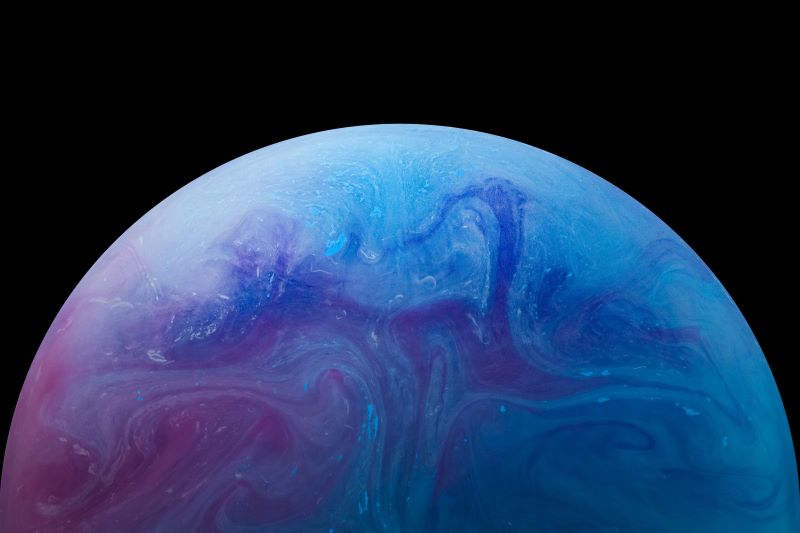
New Evidence for Planet 9
There are growing cases that a planet the size of Neptune – Planet 9 – lurks deep in the outskirts of our solar system. Researchers from Caltech, Université Côte d’Azur and the Southwest Research Institute shared a pre-print paper on April 17, 2024. In it, they argue that a group of small bodies beyond Neptune are clustering together due to the gravitational influence of Planet 9. These distant bodies in the solar system are not evenly distributed in their orbits like the rocky boulders of the asteroid belt. Instead, they form clumped groups. So, researchers think a larger, more distant object gravitationally pulls them together in this pattern. And that’s how planet eight – Neptune – was discovered. Neptune was pulling on the orbit of Uranus.
Two of the four authors of the new paper, Konstantin Batygin and Mike Brown of Caltech, are behind the Planet 9 theory. In fact, Mike Brown wrote a book about his life and research in the far reaches of our solar system : including the reclassification of Pluto. The book is called How I Killed Pluto and Why It Happened. But these researchers believe there is an object much larger than Pluto, further away in our solar neighborhood. This planet would be the size of five Earths (about the size of Neptune) and would be 400 to 800 times further from the Sun than Earth.
Letters from the astrophysical journal accepted the article for publication. It has not yet undergone peer review. A copy of the article is available on arXiv.
Help spread the wonders of astronomy! Please donate now to EarthSky.org and make sure people around the world can learn more about the night sky and our universe.
Batygin on the Event Horizon podcast
Batygin said on John Michael Godier’s Event Horizon podcast that this is:
…the fifth and most statistically significant evidence we have to date of the existence of Planet 9.
Batygin also said:
What we looked at in this article is a population of trans-Neptunian objects that we had ignored until now. These are populations of long-lived, icy, asteroid-like objects that typically live beyond Neptune’s orbit…but whose orbits pierce Neptune’s orbit. We also looked specifically at the population of Neptune cruisers that live near the plane of the solar system.
So, as objects cross Neptune’s orbit and are pushed by the giant planet, if left alone they would have scattered. As Batygin said:
The fact that we see them requires some form of gravitational influence. …What we show in this paper is that not only does Planet 9 measure up, but the orbital distribution predicted by Planet 9 is perfectly consistent with what we see in the data.
In fact, Batygin stated that a solar system without planet 9 can be ruled out with a confidence level of five sigma. This value, in fields such as particle physics, is considered sufficient to declare a discovery. This is a “gold standard,” equal to approximately one chance in a million that the outcome is random.
Planet 9, galactic tide or black hole?
Are there other theories than Planet 9 that could explain the grouping of trans-Neptunian objects? One of these theories concerns the galactic tide. And the researchers looked at this gravitational pull coming from the galaxy itself. But they discovered that some features of the distribution of objects cannot be reproduced with the galactic tide. However, the Planet 9 theory fits perfectly.
Another theory, not discussed in the article, is that Planet 9 could instead be a black hole. If there are black holes wandering far into the distant solar system, Harvard astronomer Avi Loeb has proposed a way to search for them. They would look for flares during black hole encounters with small, distant objects.
The upcoming Vera Rubin Observatory could be the tool to provide the crucial data to solve the mystery of Planet 9 or the solar system’s black holes. The telescope is expected to be operational by early 2025.
Unfortunately, the new data from the recent study does not help us find the direction in which to point our telescopes to see Planet 9. So the hunt continues.
Announcement on social networks
Here’s how lead author Konstantin Batygin announced the discovery on social media:
A first key clue for Planet 9 appeared almost ten years ago: Kuiper belt objects at high perihelion are grouping together. Neptune’s gravitational scattering disrupts this model, so the focus has remained on the dynamically stable (Sedna-type) TNOs, ignoring the unstable ones. pic.twitter.com/YNZ0Yrauy3
– Konstantin Batygin (@kbatygin) April 18, 2024
Given their dynamic instability, only two scenarios can maintain this population of TNOs in a stable state: either they are pushed inwards by the interaction between the galactic tide and the diffusion of Neptune, or they result from the induced dynamics by Planet 9 (as shown in Figure ). pic.twitter.com/HBEqm0UO9J
– Konstantin Batygin (@kbatygin) April 18, 2024
But what about observation bias? After adjustment, the data favors the Planet 9 model by a striking 5 sigma. Surprisingly, this “non-exotic” group of TNOs provides the strongest statistical evidence to date that Planet 9 actually exists… pic.twitter.com/LksVpOyfS1
– Konstantin Batygin (@kbatygin) April 18, 2024
Conclusion: The researchers said that the clustering of small objects beyond Neptune’s orbit perfectly matches the existence of a Planet 9 hidden on the outskirts of our solar system.
Source: Generation of low inclination TNO crossing Neptune by Planet Nine
Via Event Horizon